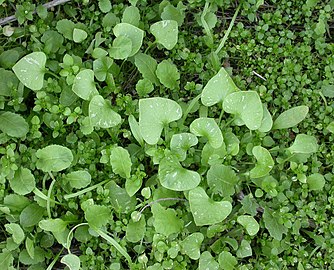Claytonia perfoliata
| Claytonia perfoliata | |
|---|---|

| |
| C. perfoliata subsp. perfoliata growing wild in Anacortes, Washington | |
| Scientific classification | |
| Kingdom: | Plantae |
| Clade: | Tracheophytes |
| Clade: | Angiosperms |
| Clade: | Eudicots |
| Order: | Caryophyllales |
| Family: | Montiaceae |
| Genus: | Claytonia |
| Species: | C. perfoliata
|
| Binomial name | |
| Claytonia perfoliata Willd. | |
| Synonyms[1] | |
| |
Claytonia perfoliata, commonly known as miner's lettuce, rooreh, Indian lettuce, or winter purslane, is a flowering plant in the family Montiaceae. It is an edible, fleshy, herbaceous, annual plant native to the western mountain and coastal regions of North America.
Description
Claytonia perfoliata is a tender
The small pink or white
C. perfoliata is common in the springtime, and prefers a cool, damp environment. The plant first appears in sunlit areas after the first heavy rains of the year, though the best stands are found in shaded areas, especially in the uplands, into early summer. As the days get hotter and drier, the leaves turn a deep red color as they dry out.
Taxonomy
Together with two other
Subspecies
There are three well-studied geographical subspecies of C. perfoliata:[4]
- Claytonia perfoliata subsp. perfoliata: Pacific coastal United States and Canada (British Columbia)
- Claytonia perfoliata subsp. intermontana: interior western United States
- Claytonia perfoliata subsp. mexicana: coastal southern California and Arizona, all the way south to Mexico to Guatemala
Other names
C. perfoliata is called 'piyada̠' in the Western Mono language and 'palsingat' in Ivilyuat — two Native American languages of California[6] or 'rooreh' in (Ohlone language)[7]
Distribution and habitat
The species is native to Mexico and western north America as far north as British Columbia.[8]
It has been introduced into and is widely
Uses

The
The plant is known as palsingat or, possibly, lahchumeek in Ivilyuat and it was eaten fresh or boiled as a green by the Ivilyuqaletem (Cahuilla) people of Southern California. It, along with Claytonia exigua, is available for gathering in the early spring.[19]
References
- ^ "The Plant List: A working list of all plant species". Royal Botanic Gardens Kew and Missouri Botanic Garden. Retrieved 8 May 2016.
- ^
Elias, Thomas S.; Dykeman, Peter A. (2009) [1982]. Edible Wild Plants: A North American Field Guide to Over 200 Natural Foods. New York: OCLC 244766414.
- ^ a b McIntyre, P. J. 2012. Cytogeography and genome size variation in the Claytonia perfoliata (Portulacaceae) polyploid complex. Annals of Botany (Oxford) 110(6): 1195-203
- ^ ISBN 0-912861-78-9
- ^ McIntyre, P. J. 2012. Polyploidy associated with altered and broader ecological niches in the Claytonia perfoliata (Portulacaceae) species complex. American Journal of Botany 99(4): 655-62.
- ^ "A Dictionary of Western Mono: Second Edition"
- ^ "rooreh", Wiktionary, 2020-09-06, retrieved 2023-04-28
- ^ a b "Claytonia perfoliata Donn. ex Willd". Plants of the World Online. Royal Botanic Gardens, Kew. Retrieved 28 April 2023.
- ^ Hank Shaw (March 7, 2011). "Foraging for Miner's Lettuce, America's Gift to Salad". The Atlantic. Retrieved 2013-04-06.
- ^ Archibald Menzies (1923). Menzies' Journal of Vancouver's Voyage, April to October, 1792 [extract]. W. H. Cullin Printers. Retrieved 2013-04-07.
- ^ P.A. Stroh; T. A. Humphrey; R.J. Burkmar; O.L. Pescott; D.B. Roy; K.J. Walker (eds.). "Claytonia perfoliata Donn ex Willd". BSBI Online Plant Atlas 2020. Retrieved 28 April 2023.
- S2CID 244520656.
- ISBN 9781466585942.
- ISBN 9780598280268.
- ^ Rev. William Taylor's account of using miner's lettuce to treat scurvy: Taylor, William (1860). California Life Illustrated. New York, New York, USA: Carlton & Porter. pp. 230–231.
- ^ Lyons, C. P. (1956). Trees, Shrubs and Flowers to Know in Washington (1st ed.). Canada: J. M. Dent & Sons. p. 106.
- ISBN 978-1-4930-1499-6.
- ^ "Miner's Lettuce". UC IPM Online. UC Davis.
- ISBN 978-0939046249.



